Ayurvedic Nutrition & Cooking
“When diet is wrong medicine is of no use. When diet is correct medicine is of no need. “
— Charaka Samhita, author of ancient Vedic text, scholar, physician
Ayurvedic food and nutrition is not a particular type of diet like vegetarianism, veganism, paleo or even Indian food, but a general name for a number of guidelines on how to properly prepare and combine various foods in a way that is beneficial to health and supports your individual constitution. Eating ayurvedically is not complicated or expensive. It consists of eating whole grains, fresh vegetables, legumes, nuts and seeds, healthy fats such as ghee, and preparing food in a way that optimises strong Agni - digestive fire - along with a loving attitude.
Eating food compatible with your body-type and cooking with awareness based on principles to help digestion and regular elimination, play a central role in Ayurvedic medicine. Ayurveda further teaches us about the 6 tastes and qualities of food to help balance our doshas i.e. body intelligence based on the five elements.
Ayurveda promotes vegetarian cuisine, although animal products can be proscribed for therapeutic purposes.
Just like Ayurvedic therapies, Ayurvedic nutrition is also personalised – it modifies according to individual physiology and cyclical changes in nature. An ayurvedic treatment plan will always include specific dietary guidelines as well as tips for preparing simple, delicious vegetarian dishes that help to balance your physiology.
AYURVEDIC COOKING
Ayurvedic cooking is about guiding principles rather than rules:
Food should be light, easy to digest and assimilate; heavier food is OK in winter but in summer it needs to be lighter
Use spices intelligently to promote good digestion and balance the doshas
Cooked food is considered easier to digest than raw
Certain foods do not go well with others eg: dairy foods do not go well with most fruits due to different tastes and energetics ie. no more banana smoothies!
Different sorts of food are required at different times eg: pregnancy, during and post-illness
Ideal foods are ‘tri-doshic’, balancing all three doshas eg: green moong dal and kitchari
Ayurvedic cooking classes
Learn to make an ayurvedic breakfast, kitchari, ghee and enjoy sipping on chai together. Available by appointment. Min. 3 people.
Please please enquire by phone or email on the Contact page.
AYURVEDIC NUTRITION
THE SIX TASTES
The 6 Tastes to Create Balanced ‘Complete’ Meals
Unlike western nutrition trying to count calories, chasing vitamins and minerals, watching carbs and looking for complete proteins, Ayurveda simply says that each meal must contain the six tastes in reasonable ratios to nourish the body and mind. If each of the six tastes is present in each meal, then all the nutrients your body needs will be present in the foods. They are:
Sweet Sour Salty Pungent Bitter Astringent
Sweet: Earth & Water elements
Qualities - cooling, heavy, oily
Anabolic effect ie. it helps to nourish and build tissue in the body when there is depletion
On a more subtle level, the sweet taste enhances the vital essence, or Ojas, and promotes a feeling of love and well-being
Particularly grounding for Vata’s airy, nervous energy
In the right amount, the cooling quality of sweet can be soothing for Pitta’s fire
Increases Kapha, leading to weight gain
Examples: Natural sugar, dates, honey, maple syrup, liquorice, more subtly in grains like rice and wheat, milk
Sour: Earth & Fire elements
Qualities - warming
Decreases Vata and increases Pitta and Kapha
Helps to stimulate salivary secretions, enhance appetite and aid digestion
In excess, the sour taste can create acid indigestion, hyperacidity, heartburn, and ulcers
Vata types - stimulating to their delicate digestion
Pitta types - often provides more heat than they can handle (watch ferments)
Kapha types - can cause heaviness as a result of water retention
Psychologically, sour enlivens the mind, and brings comprehension and discrimination. In excess a “sour grapes” attitude.
Examples: Lemons, grapefruit, vinegar, ferments, yoghurt
Salty: Water & Fire elements
Qualities - warming
Vata types - helpful because it is warming, it stimulates digestion and helps to hold in moisture
Pitta types - moderate because it’s heating
Kapha types - although the warmth is good, the excess water can cause an imbalance
Anabolic in nature so builds and nourishes tissues
In moderation, it gives energy, promotes growth and balances electrolytes
Too much salt can lead to hypertension, oedema, swelling, ulcers and hyperacidity
Emotionally, the salty taste enhances the flavours and variety of life, sparks interest and builds confidence and courage
Examples: Salt, seaweeds, salted nuts
Pungent, Bitter & Astringent
In the modern diet, we have far less of these consumed in our meals but these tastes keep the body from accumulating excessive tissue and fat, assisting in daily detoxification and are the source for many of the nutrients outside of carbs and proteins.
Bitter: Air & Ether elements
Qualities - cool, light, and dry
Detoxifying
Increases Vata and decreases Pitta and Kapha
Enhances the flavours of all other foods
Anti-bacterial and anti-viral in nature
Especially balancing for Pitta, helping to cool excess heat, aid digestion, and cleanse the liver
Helps to reduce fat and toxins, making it the perfect taste to balance kapha individuals.
In excess, the bitter taste will deplete the tissues, causing emaciation, fatigue, dizziness, and extreme dryness
Psychologically, the bitter taste in excess can lead to isolation, grief and loneliness.
Examples: Leafy greens like collards, arugula and radicchio, coffee, dandelion and turmeric
Pungent: Fire & Air elements
Qualities - heating, light, and drying
Increases Vata and Pitta and decreases Kapha
In moderation, it helps digestion and circulation
Helps to dissolve excess fat, and eliminate it from the body
In excess it can create inflammation, irritation, ulceration, diarrhoea, heartburn & nausea
Psychologically, the pungent taste promotes enthusiasm and clarity of perception. In excess, it can bring irritability, envy, jealousy, and anger.
Examples: Chilies, garlic, black pepper, ginger and asafoetida
Astringent: Air & Earth elements
Qualities - Cooling, drying, heavy in nature
Increases Vata and decreases Pitta and Kapha
Improves absorption, is anti-inflammatory and decongestant
Excess astringency can create constipation, gripping sensations in the intestine, and stagnation of circulation
Psychologically, it brings grounding and organisation. Too much astringent taste can create many Vata-type mental disorders such as fear, anxiety, nervousness, and a scattered mind.
Examples: Pomegranates, asparagus, green beans, chickpeas, and turmeric
You can help balance a dosha aggravation by choosing to consume food and drinks that have a particular dominant ‘taste’, which has an effect on your mind and body’s function.
Tastes that balance the Doshas
Vata - Sweet, sour and salty
Pitta - Sweet, bitter, and astringent
Kapha- Bitter, pungent, and astringent
Tastes that cause imbalance to the Doshas in excess:
Vata - Bitter, pungent, and astringent
Pitta - Sour, salty, pungent
Kapha- Sweet, sour and salty









